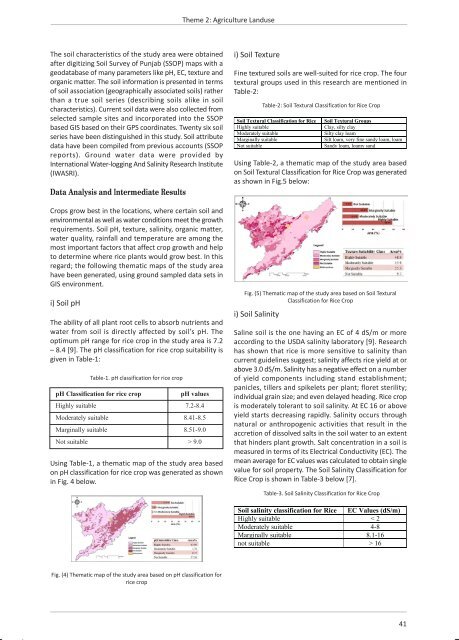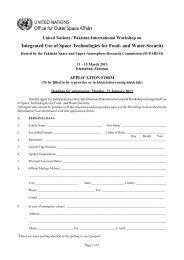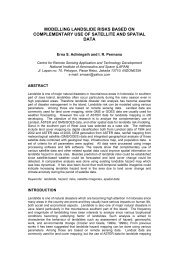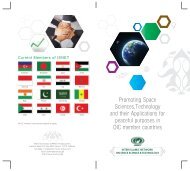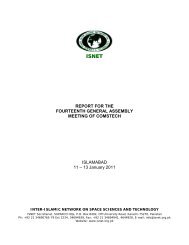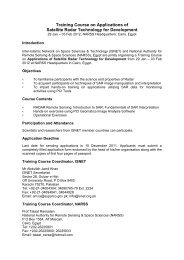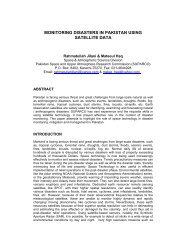Workshop Proceedings - Inter Islamic Network on Space Sciences ...
Workshop Proceedings - Inter Islamic Network on Space Sciences ...
Workshop Proceedings - Inter Islamic Network on Space Sciences ...
You also want an ePaper? Increase the reach of your titles
YUMPU automatically turns print PDFs into web optimized ePapers that Google loves.
Theme 2: Agriculture Landuse<br />
The soil characteristics of the study area were obtained<br />
after digitizing Soil Survey of Punjab (SSOP) maps with a<br />
geodatabase of many parameters like pH, EC, texture and<br />
organic matter. The soil informati<strong>on</strong> is presented in terms<br />
of soil associati<strong>on</strong> (geographically associated soils) rather<br />
than a true soil series (describing soils alike in soil<br />
characteristics). Current soil data were also collected from<br />
selected sample sites and incorporated into the SSOP<br />
based GIS based <strong>on</strong> their GPS coordinates. Twenty six soil<br />
series have been distinguished in this study. Soil attribute<br />
data have been compiled from previous accounts (SSOP<br />
reports). Ground water data were provided by<br />
<str<strong>on</strong>g>Inter</str<strong>on</strong>g>nati<strong>on</strong>al Water-logging And Salinity Research Institute<br />
(IWASRI).<br />
Data Analysis and <str<strong>on</strong>g>Inter</str<strong>on</strong>g>mediate Results<br />
Crops grow best in the locati<strong>on</strong>s, where certain soil and<br />
envir<strong>on</strong>mental as well as water c<strong>on</strong>diti<strong>on</strong>s meet the growth<br />
requirements. Soil pH, texture, salinity, organic matter,<br />
water quality, rainfall and temperature are am<strong>on</strong>g the<br />
most important factors that affect crop growth and help<br />
to determine where rice plants would grow best. In this<br />
regard; the following thematic maps of the study area<br />
have been generated, using ground sampled data sets in<br />
GIS envir<strong>on</strong>ment.<br />
i) Soil pH<br />
The ability of all plant root cells to absorb nutrients and<br />
water from soil is directly affected by soil’s pH. The<br />
optimum pH range for rice crop in the study area is 7.2<br />
– 8.4 [9]. The pH classificati<strong>on</strong> for rice crop suitability is<br />
given in Table-1:<br />
pH Classificati<strong>on</strong> for rice crop<br />
Highly suitable<br />
Moderately suitable<br />
Marginally suitable<br />
Not suitable<br />
Table-1. pH classificati<strong>on</strong> for rice crop<br />
pH values<br />
7.2-8.4<br />
8.41-8.5<br />
8.51-9.0<br />
> 9.0<br />
Using Table-1, a thematic map of the study area based<br />
<strong>on</strong> pH classificati<strong>on</strong> for rice crop was generated as shown<br />
in Fig. 4 below.<br />
i) Soil Texture<br />
Fine textured soils are well-suited for rice crop. The four<br />
textural groups used in this research are menti<strong>on</strong>ed in<br />
Table-2:<br />
Table-2: Soil Textural Classificati<strong>on</strong> for Rice Crop<br />
Using Table-2, a thematic map of the study area based<br />
<strong>on</strong> Soil Textural Classificati<strong>on</strong> for Rice Crop was generated<br />
as shown in Fig.5 below:<br />
Fig. (5) Thematic map of the study area based <strong>on</strong> Soil Textural<br />
Classificati<strong>on</strong> for Rice Crop<br />
i) Soil Salinity<br />
Saline soil is the <strong>on</strong>e having an EC of 4 dS/m or more<br />
according to the USDA salinity laboratory [9]. Research<br />
has shown that rice is more sensitive to salinity than<br />
current guidelines suggest; salinity affects rice yield at or<br />
above 3.0 dS/m. Salinity has a negative effect <strong>on</strong> a number<br />
of yield comp<strong>on</strong>ents including stand establishment;<br />
panicles, tillers and spikelets per plant; floret sterility;<br />
individual grain size; and even delayed heading. Rice crop<br />
is moderately tolerant to soil salinity. At EC 16 or above<br />
yield starts decreasing rapidly. Salinity occurs through<br />
natural or anthropogenic activities that result in the<br />
accreti<strong>on</strong> of dissolved salts in the soil water to an extent<br />
that hinders plant growth. Salt c<strong>on</strong>centrati<strong>on</strong> in a soil is<br />
measured in terms of its Electrical C<strong>on</strong>ductivity (EC). The<br />
mean average for EC values was calculated to obtain single<br />
value for soil property. The Soil Salinity Classificati<strong>on</strong> for<br />
Rice Crop is shown in Table-3 below [7].<br />
Table-3. Soil Salinity Classificati<strong>on</strong> for Rice Crop<br />
Fig. (4) Thematic map of the study area based <strong>on</strong> pH classificati<strong>on</strong> for<br />
rice crop<br />
41


